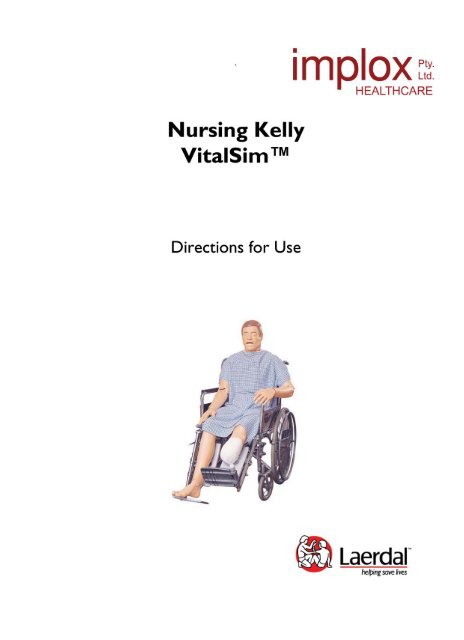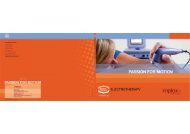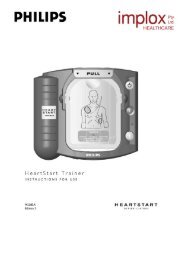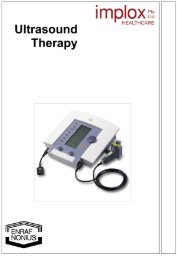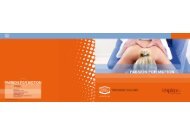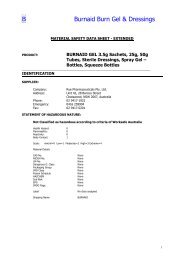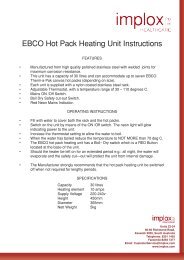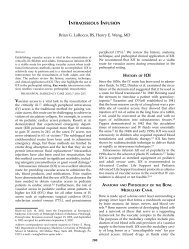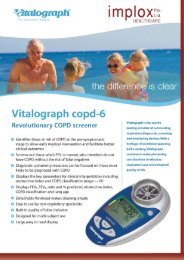Directions for Use - Implox
Directions for Use - Implox
Directions for Use - Implox
You also want an ePaper? Increase the reach of your titles
YUMPU automatically turns print PDFs into web optimized ePapers that Google loves.
Table of Contents<br />
Laerdal Recommends 5<br />
Items Included 6<br />
Skills Taught 7<br />
Teeth 8<br />
Carotid Pulse 8<br />
Tracheostomy Plug & Care 8<br />
NG Tube Placement 9<br />
Intubation 9<br />
Chest 9<br />
Lungs 9<br />
Stomach Reservoir 9<br />
Belly Plates 10<br />
Injection Pads 10<br />
Waist, Knee and Ankle Joints 11<br />
Arms 11<br />
Legs 12<br />
IV Arm 12<br />
Replacing Skin & Vein System 13<br />
Blood Pressure Arm 15<br />
Auscultation of Heart, Breath and Bowel Sounds 16<br />
300-00001 2<br />
Laerdal
Genitalia 17<br />
Colon Reservoir 19<br />
Urinary Catheterization and<br />
Enema Simulation 19<br />
Troubleshooting 20<br />
VitalSim 20<br />
Care and Maintenance 21<br />
Warranty 21<br />
Replacement Parts 23<br />
300-00001 3<br />
Laerdal
Nursing Kelly VitalSim is a full-body, lifelike vinyl manikin<br />
designed to teach all skills from basic patient handling to<br />
advanced nursing, including the measurement of noninvasive<br />
blood pressure and the auscultation and recognition of normal<br />
and abnormal heart, lung and bowel sounds.<br />
The manufacturing quality of this simulator should provide<br />
many sessions of training when reasonable care and<br />
maintenance are practiced.<br />
Laerdal Recommends:<br />
IV Injections – 20 gauge needle, or smaller<br />
Tracheostomy Tube – Size 6<br />
NG Tube – Size 16 French<br />
Endotracheal Tube – 7.5 or smaller<br />
Laryngoscope Blade - Size #2 or #3, straight or<br />
curved blade<br />
Urethral Catheter – 16 French<br />
Enema Simulation – 7 mm<br />
300-00001 4<br />
Laerdal
Items Included:<br />
(1) Full-Body Manikin with Heart, Breath & Bowel<br />
Sounds<br />
(1) VitalSim (w/ 300-00001)<br />
(1) Articulating Blood Pressure Training Arm with BP<br />
Trainer<br />
(1) Articulating Multi-Venous IV Training Arm<br />
(1) Set of Wound Assessment and Care Modules<br />
(1) Hospital Gown<br />
(1) Male Genitalia<br />
(1) Female Genitalia<br />
(3) Urinary Valves<br />
(3) Anal Valves<br />
(1) 10 foot Manikin Connector Cable<br />
(1) Simulated Blood Concentrate<br />
(1) Manikin Lubricant Spray<br />
(1) Assembly Tool Kit<br />
Wound Assessment & Care<br />
(1) Lacerated Hand with Forearm Surgical Incision and<br />
Painted Sutures<br />
(1) Chest Surgical Incision Module<br />
(1) Abdominal Packing Module<br />
(1) Abdominal Incision Module with Painted Sutures<br />
(1) Abdominal Incision Modules with Penrose drain<br />
Staples and Nylon Sutures (One each)<br />
(1) Abdominal Subcutaneous Heparin and Insulin<br />
Injection Module<br />
(1) Thigh Packing and Irrigation Module<br />
(1) Thigh Suture Module with Nylon Sutures<br />
(1) Thigh Debridement Module<br />
(1) Infected Colostomy Stoma<br />
(1) Gluteal and Ventro-Gluteal Decubitus Ulcer<br />
Modules (One each)<br />
(1) Below Knee Amputation Stump<br />
(1) Below Elbow Amputation Stump<br />
(1) Diabetic Foot with Gangrenous Toes and Heel<br />
Decubitus ulcer<br />
(1) Varicose Vein Leg with Stasis Ulcer<br />
300-00001 5<br />
Laerdal
Skills Taught:<br />
Basic patient handling<br />
Denture care<br />
Oral hygiene<br />
Oral and nasal Intubation<br />
Eye and ear irrigation (simulated)<br />
NG Tube insertion, care medication administration and<br />
removal<br />
Lavage/Gavage<br />
Tracheostomy care and suctioning<br />
Blood pressure skills<br />
IV care and management<br />
Subcutaneous and intramuscular injection<br />
Oxygen delivery procedures<br />
Ostomy irrigation and care<br />
Catheterization skills<br />
Enema simulation<br />
Colonic irrigation<br />
Wound assessment and care<br />
Bandaging and dressing<br />
Auscultation and recognition of normal and abnormal<br />
heart, breath and bowel sounds<br />
300-00001 6<br />
Laerdal
Teeth –<br />
To remove:<br />
Grasp firmly and lift.<br />
Laerdal Recommends:<br />
Insert and remove bottom teeth first<br />
when per<strong>for</strong>ming denture care.<br />
To reinsert both sets:<br />
a. Begin on one side and work<br />
around, aligning ridges with<br />
corresponding grooves in jaws.<br />
(Dusting with baby powder<br />
is helpful.) (Photo 1)<br />
b. Press firmly into place.<br />
Photo 1<br />
Carotid Pulse –<br />
To generate a carotid pulse, use the hand held red bulb located<br />
on the right axillary side of manikin. Firmly squeeze bulb while<br />
palpating <strong>for</strong> pulse at carotid site.<br />
Tracheostomy Plug –<br />
The Tracheostomy plug may be removed by grasping firmly,<br />
then lifting up and out. To replace, press into hole.<br />
Tracheostomy Care –<br />
1. Mix solution of ½ cup mild<br />
liquid detergent and ½ cup<br />
water.<br />
2. Remove lungs and trachea.<br />
3. Pour mixture into simulated lungs.<br />
4. Fill lungs to a level where suction<br />
catheter will pick up mixture.<br />
5. Reattach lungs at connector.<br />
Laerdal<br />
Recommends:<br />
We recommend a size 6<br />
tracheostomy tube.<br />
Opening will accommodate<br />
other sizes, but a size 6 is<br />
usually most suitable.<br />
The consistency of the solution approximates the mucus<br />
normally suctioned in a tracheostomy patient.<br />
Drain and air-dry lungs immediately after each use.<br />
Be careful not to introduce fluids into speaker ports or near<br />
electronics in manikin’s chest.<br />
300-00001 7<br />
Laerdal
NG Tube Placement –<br />
This manikin features an esophagus<br />
and stomach reservoir <strong>for</strong> practice<br />
of NG tube insertion and skills such<br />
as Lavage and Gavage.<br />
Intubation –<br />
The following equipment is recommended:<br />
Laerdal Recommends:<br />
For best results, lubricate the<br />
tube with either manikin<br />
lubricant or liquid detergent<br />
prior to NG or OG tube<br />
insertion.<br />
a. Endotracheal tube, size 7.5 ID or smaller<br />
b. Manikin Lubricant spray or liquid soap<br />
c. 10 ml syringe<br />
d. Laryngoscope blade, size #2 or #3 straight or curved<br />
e. Laryngoscope handle<br />
f. NG Tube, size 16 French<br />
Remove trach plug prior to insertion of intubation tubes.<br />
Laerdal Recommends:<br />
Intubation tubes and airway passages should be sprayed<br />
with manikin lubricant spray or lubricated with liquid soap<br />
prior to intubation.<br />
Chest Plate –<br />
To remove:<br />
1. Apply pressure to center of plate.<br />
2. Work your fingers under edge of plate while lifting.<br />
To insert:<br />
1. Position plate over cavity.<br />
2. Work plate edges into groove on torso cavity.<br />
Lungs –<br />
Lungs may be removed from bronchial tubes by unscrewing<br />
them at the connector site. To replace, reverse procedure.<br />
Stomach Reservoir –<br />
The stomach reservoir attaches to esophagus with a<br />
connector. Unscrew reservoir from esophagus to fill or drain<br />
with water.<br />
300-00001 8<br />
Laerdal
Belly Plate with Multi-Sounds –<br />
To remove:<br />
1. Apply pressure to center of plate.<br />
2. Work your fingers under edge of<br />
plate while lifting.<br />
3. Disconnect bowel sound speaker<br />
connector to release plate.<br />
Laerdal Recommends:<br />
Dusting with talcum powder is<br />
helpful in replacing belly plates.<br />
To insert:<br />
1. Position plate over cavity.<br />
2. Reconnect bowel sound speaker.<br />
3. Work plate edges into groove on pelvis cavity.<br />
Belly Plate with Colostomy Stoma –<br />
To remove:<br />
1. Apply pressure to center of plate.<br />
2. Work fingers under edge while lifting.<br />
(Photo 2)<br />
Photo 2<br />
To insert:<br />
1. Attach valve and genitalia.<br />
2. Work plate edges into pelvis cavity.<br />
The belly plate with colostomy also serves as the urinary<br />
reservoir.<br />
To fill reservoir:<br />
a. Remove colostomy stoma.<br />
b. Fill with fluid.<br />
c. Gently reinsert stoma.<br />
Injection Pads –<br />
a. To remove, squeeze pad<br />
with fingers and pull.<br />
b. To replace, squeeze pad<br />
and insert in opening.<br />
Laerdal Recommends:<br />
Make sure genitalia and urinary<br />
connectors are in place prior to<br />
filling.<br />
Laerdal Recommends:<br />
Dusting pads with talcum powder<br />
will assist with reinsertion.<br />
Injection pads may be injected with water. Foam should be<br />
removed from pads immediately following training. Squeeze<br />
out fluid and air dry.<br />
300-00001 9<br />
Laerdal
Waist, Knee and Ankle<br />
Joints –<br />
These joints are connected<br />
with a bolt and lock nut.<br />
To remove, unscrew lock nut<br />
and pull bolt from joint.<br />
Segments will now easily<br />
disconnect.<br />
Laerdal Recommends:<br />
When assembled, talcum powder<br />
should be used in joints to assist<br />
articulation.<br />
Arms –<br />
Arms are attached with<br />
a 4 ½” long bolt, three<br />
washers, a spring and<br />
a wing nut.<br />
Attachment<br />
hardware is<br />
located in<br />
envelope inside<br />
carton.<br />
To attach:<br />
1. Remove chest plate.<br />
2. Locate hole in shoulder.<br />
3. Remove deltoid injection pad<br />
from arm by squeezing skin in<br />
center of pad while pulling.<br />
4. Slide small washer over bolt.<br />
5. Insert bolt through hole in<br />
arm and hole in manikin’s shoulder.<br />
6. Add large washer, spring, another large washer and wing<br />
nut to bolt. (Figure 1)<br />
7. <strong>Use</strong> a screwdriver to hold bolt steady while tightening wing<br />
nut.<br />
8. Reinsert chest plate and deltoid pad.<br />
Fig. 1<br />
To remove arms, reverse procedure.<br />
300-00001 10<br />
Laerdal
Legs –<br />
Legs are attached with a 6” long<br />
bolt, a spring, a large washer, a<br />
small washer and a wing nut.<br />
Attachment<br />
hardware is located<br />
in envelope inside<br />
carton.<br />
To attach:<br />
1. Remove belly plate from manikin to locate hole in hip.<br />
2. Remove thigh injection pad from leg by squeezing skin in<br />
center of pad while pulling.<br />
3. Slide spring and small washer over bolt.<br />
4. Insert bolt through hole in thigh.<br />
5. Insert bolt through hole in pelvis.<br />
6. Slide large washer and wing nut over bolt.<br />
7. <strong>Use</strong> screwdriver to hold bolt while tightening wing nut.<br />
(Figure 2)<br />
Fig. 2<br />
To remove legs, reverse procedure.<br />
IV Arm –<br />
Multiple Venipuncture sites:<br />
Dorsal Veins of Hand (3)<br />
Antecubital<br />
Cephalic Vein<br />
Median Vein<br />
Basilic Vein<br />
<strong>Directions</strong> <strong>for</strong> <strong>Use</strong>:<br />
1. Attach IV bag to IV tubing.<br />
2. Attach IV tubing to either latex vein.<br />
Laerdal Recommends:<br />
A 20 gauge needle or smaller is<br />
recommended to extend the life of<br />
the IV Arm.<br />
When using an IV catheter,<br />
lubricate with manikin lubricant <strong>for</strong><br />
easier insertion.<br />
2. Allow fluid to flow through arm and out other latex vein.<br />
3. Clamp off flow of water from open vein.<br />
The arm is now ready to practice venipuncture.<br />
300-00001 11<br />
Laerdal
Laerdal Recommends:<br />
When excessive leaking occurs at puncture sites, either a new<br />
vein system or skin should be installed to reduce loss of fluid.<br />
We recommend working at a sink when replacing the skin and<br />
vein system.<br />
Replacing Skin and Veins:<br />
Remove skin:<br />
If replacing skin and veins, cut off skin.<br />
This can be done with a sharp knife,<br />
scalpel or scissors. (Figure 3) When<br />
finished, discard skin.<br />
Replacing veins: (Keeping skin)<br />
1. Lubricate inside of skin with<br />
liquid detergent; let it flow<br />
down into the finger area.<br />
2. Begin at top of arm and slowly<br />
pull skin down and off of arm.<br />
Do not roll, as that will<br />
cause skin to bind. Thumb<br />
will detach with skin.<br />
3. Remove tubing from track in<br />
mandrel. Glue may need to be<br />
scraped away to allow removal.<br />
4. Rinse and dry vein grooves well and swab with<br />
alcohol. Be sure to remove any excess glue.<br />
Fig. 3<br />
300-00001 12<br />
Laerdal
5. Place new veins along grooves, (Figures 4 & 5) spot<br />
gluing as needed. (We recommend a fast-drying<br />
glue.)<br />
Fig. 4<br />
Fig. 5<br />
6. Generously lather arm mandrel with liquid soap.<br />
Laerdal Recommends<br />
Heat arms skins be<strong>for</strong>e replacing on mandrel.<br />
This can be done with a blow-dryer.<br />
7. Slide hand into skin. (Photo 3)<br />
Photo 3<br />
300-00001 13<br />
Laerdal
8. Work skin over fingers, as with a glove. (Photo 4)<br />
Photo 4<br />
9. Work arm skin up, over mandrel. (Photos 5 & 6)<br />
Photo 5<br />
Photo 6<br />
Blood Pressure Arm –<br />
1. Place Blood Pressure Cuff on arm.<br />
2. Attach tubing on cuff to clear tube,<br />
located underneath<br />
Nursing Kelly’s arm. Photo 7<br />
(Photo 7)<br />
3. See VitalSim DFU <strong>for</strong> complete<br />
Blood Pressure operating procedures.<br />
Laerdal Recommends:<br />
Do not insert needles into blood pressure arm.<br />
300-00001 14<br />
Laerdal
Auscultation of Heart, Breath and Bowel<br />
Sounds –<br />
1. Connect Nursing Kelly to VitalSim Unit, via cable<br />
located on back of manikin. (Photo 8)<br />
2. See VitalSim DFU <strong>for</strong> complete Heart, Breath<br />
and Bowel Sound Auscultation.<br />
Photo 8<br />
300-00001 15<br />
Laerdal
Genitalia:<br />
Both male and female genitalia have been provided <strong>for</strong> urinary<br />
catheterization and enema training procedures.<br />
Tube-like valves, with a screw cap on one end, connect urethra<br />
and anus to corresponding reservoirs. This cap must be<br />
connected to genitalia openings. Soft vinyl end of connector is<br />
attached to urinary and anal reservoirs with a white clamp.<br />
(Long valve connects urinary reservoir; short valve<br />
connects anal reservoir.)<br />
Pelvic support pin must be removed and replaced immediately<br />
when assembling and disassembling genitalia. (Figure 6)<br />
Fig. 6<br />
Laerdal<br />
Recommends<br />
Pelvic support pin<br />
must be replaced.<br />
Failure to replace pin<br />
will result in pelvic<br />
spread.<br />
If this occurs, the<br />
genitalia module will<br />
no longer fit properly<br />
To disassemble:<br />
in the manikin.<br />
1. Lift up on belly plate.<br />
2. Pull upper portion of genitalia back to remove pelvic<br />
support pin.<br />
3. Belly plate, genitalia with connectors, and colon reservoir<br />
may now be removed simultaneously.<br />
300-00001 16<br />
Laerdal
Colon Reservoir –<br />
Colon reservoir inserts into pelvic<br />
cavity with narrow end downward<br />
and connector pointing outward.<br />
This connector attaches reservoir<br />
to anal valve on genitalia.<br />
(Photo 12)<br />
Reservoir should be removed from<br />
manikin, inverted, drained and<br />
completely air-dried be<strong>for</strong>e storing.<br />
Photo 12<br />
Urinary Catheterization and Enema<br />
Simulation –<br />
Laerdal<br />
Recommends:<br />
Catheters should be<br />
well lubricated with<br />
manikin lubricant or full<br />
strength liquid soap<br />
prior to using.<br />
After several uses, catheter may<br />
“hang” when water has washed<br />
away lubricant, causing friction<br />
and binding. If this occurs,<br />
generously lubricate a catheter<br />
and insert into urethra several<br />
times.<br />
If catheter hangs during removal, work it with an “in and out”<br />
motion. <strong>Use</strong> warm water in reservoirs when possible to keep<br />
soap from clogging the catheters. Make sure reservoirs are<br />
well drained of all water be<strong>for</strong>e disconnecting valves.<br />
Laerdal<br />
Recommends:<br />
A size 16 French<br />
catheter is suggested <strong>for</strong><br />
urethral catheterization.<br />
Size 7mm catheter is<br />
suggested <strong>for</strong> enema<br />
simulation.<br />
Check List <strong>for</strong> Valves<br />
That May Leak:<br />
a. Do valve connections<br />
have an O-ring?<br />
b. Does the white clamp fit<br />
firmly against base of valve?<br />
c. Are valves attached correctly?<br />
d. If valves are attached<br />
correctly, are they properly<br />
connected to reservoirs and to<br />
genitalia?<br />
300-00001 18<br />
Laerdal
Troubleshooting –<br />
What can I do if my manikin develops a pelvic spread?<br />
Cinch pelvis with a belt and heat with a hair dryer to soften,<br />
cinching as you heat. Insert pin, leaving belt in place until cool.<br />
What do I do if my connectors leak?<br />
Make sure C-clamps are squeezed tightly into place and<br />
connectors are screwed on tightly.<br />
What can I do if I can’t remove my catheter?<br />
Make sure the cuff is deflated.<br />
VitalSim Connection<br />
See Vital DFU <strong>for</strong> complete<br />
connection and operating<br />
procedures.<br />
300-00001 19<br />
Laerdal
Care and Maintenance<br />
1. Clean with mild soap and water; do not submerse manikin<br />
or parts in cleaning fluids or water. Apply a light coat of<br />
talcum powder to the face and chest skin to achieve skinlike<br />
feeling.<br />
2. <strong>Use</strong> only on clean surface. Avoid felt tipped markers, ink<br />
pens, acetone, iodine or other staining products and avoid<br />
placing the manikin on newsprint or inked lines of any kind.<br />
3. To ensure longevity, each manikin should be cleaned after<br />
each training session and a general inspection should be<br />
conducted regularly.<br />
4. Modules and all other parts should be drained and air-dried<br />
thoroughly be<strong>for</strong>e storage and disinfected when needed.<br />
After use of injection pads (use water only), accumulated<br />
water should be squeezed out. Do not store wet foam<br />
pads in the skin. To prevent mildew or mold, pads can be<br />
soaked in a mild solution of disinfectant and water or<br />
bleach and water. Squeeze excess solution from pads, allow<br />
them to dry, then store or reinsert in manikin.<br />
5. Articulating parts will benefit from a light application of<br />
talcum powder prior to training sessions.<br />
6. Store properly between teaching sessions.<br />
Warranty<br />
Laerdal Medical warrants to the purchaser that its products are<br />
free from defects in material and workmanship <strong>for</strong> a period of<br />
one (1) year from the date of purchase by the original user.<br />
During the designated one (1) year period, Laerdal Medical will,<br />
upon receipt of a product found to be defective due to<br />
materials or workmanship from the purchaser and notification<br />
in writing of the defect, at its option repair or replace any parts<br />
found to be defective or the entire product. Warranty period<br />
does not renew with replacement or repair of original product.<br />
Products found to be defective and notification of defects may<br />
also be sent to the authorized Laerdal Medical dealer from<br />
whom the product was purchased. All postage, shipping or<br />
handling charges shall be the sole responsibility of the<br />
purchaser.<br />
Laerdal Medical is responsible <strong>for</strong> the effects of safety,<br />
reliability and per<strong>for</strong>mance of its product(s) only if:<br />
300-00001 20<br />
Laerdal
– service, repair, readjustment or modification is carried out<br />
by Laerdal Medical or persons authorized by Laerdal<br />
Medical.<br />
– the electrical installation of the room where the product is<br />
used complies with pertinent equipment requirements.<br />
– the product is used in the proper manner in strict<br />
compliance with its <strong>Directions</strong> <strong>for</strong> <strong>Use</strong>.<br />
Laerdal Medical shall not be liable under this warranty <strong>for</strong><br />
incidental or consequential damages, or in the event any<br />
unauthorized repairs or modifications have been made or<br />
attempted, or when the product, or any part thereof, has been<br />
damaged by accident, misuse or abuse. This warranty does not<br />
cover batteries, fuses, normal wear and tear, excessive use,<br />
staining, discoloration or other cosmetic irregularity which<br />
does not impede or degrade product per<strong>for</strong>mance.<br />
Some states in the USA do not allow the exclusion or<br />
limitation of incidental or consequential damages, so those<br />
limitations or exclusions may not apply to you.<br />
There are no other express or implied warranties, whether of<br />
merchantability, fitness or purpose, or otherwise, on the<br />
product, its parts and accessories.<br />
Cautions and Warnings<br />
This product contains Natural Rubber latex which may<br />
cause allergic reactions when in contact with humans.<br />
300-00001 21<br />
Laerdal
REPLACEMENT PARTS:<br />
Product Number:<br />
Description:<br />
312029 Kit, Skin/Vein Adult<br />
Multi-Venous IV Arm<br />
380200 Arm Assembly, Blood<br />
Pressure<br />
380460 Genitalia, Blank-Adult<br />
Male<br />
380471 Plug, Belly plate-Adult<br />
380475 Pin, Pelvis<br />
380600 Leg Assembly, Left<br />
Adult<br />
380650 Leg Assembly, Right<br />
Adult<br />
380700 Arm, Male Multi-Venous<br />
IV Training<br />
380800 Arm Assembly, Left<br />
Plain Adult<br />
380801 Hand, Left Adult Male<br />
381401 Arm, Upper Right Adult<br />
Male<br />
381402 Pad Assembly, Deltoid<br />
Injection Adult<br />
381403 Stoma, Infected<br />
Colostomy<br />
381404 Stump, Left Lower Leg<br />
381410 Foot, Diabetic Right<br />
Adult<br />
381411 Pad, Thigh Packing<br />
Adult<br />
381412 Pad, Thigh Sutured<br />
Adult<br />
381413 Leg, Varicose Lower<br />
Right Adult<br />
381414 Pad, Gluteal Ulcerated<br />
Adult Male<br />
381415 Pad, Ventro-Gluteal<br />
Ulcerated Adult Male<br />
381416 Hand, Lacerated<br />
w/Forearm Adult Male<br />
381417 Pad, Thigh<br />
Debridement Adult<br />
200-00550 Cuff Assembly, Blood<br />
Pressure VitalSim<br />
300-00150 Pad Assembly, Thigh<br />
Injection Adult<br />
300-00001 22<br />
Laerdal
300-00250 Pad Assembly, Ventral<br />
Gluteal Injection Adult<br />
Male<br />
300-00350 Pad Assembly, Gluteal<br />
Injection Adult Male<br />
300-00450 Valve/Clamp Set, Anal<br />
Hosp Urin/Anal CVK<br />
300-00550 Valve/Clamp Set,<br />
Urinary Hosp Adult<br />
300-00650 Lubricant, Manikin-4 oz<br />
Bottle W/Sprayer<br />
300-00750 Blood, Simulated-4 oz<br />
Red<br />
300-00850 Plug, Tracheostomy<br />
300-00950 Denture Set,<br />
Upper/Lower Adult<br />
300-01050 Wound Set, Care and<br />
Assessment Adult Male<br />
300-01150 Head Assembly,<br />
VitalSim W/Trach Plug<br />
Adult Male<br />
300-01350 Reservoir Assembly,<br />
Stomach-Hosp Adult<br />
Male<br />
300-01550 Lung Bag Assembly<br />
300-01650 Chest plate Assembly,<br />
VitalSim Hosp Adult<br />
Male<br />
300-01750 Stump, Right Forearm<br />
Adult Male<br />
300-01850 Teeth, Upper-Adult<br />
300-01950 Teeth, Lower-Adult<br />
300-02050 Belly plate Assembly,<br />
Hosp w/Speakers Adult<br />
300-02150 Belly plate Assembly,<br />
Hosp 3 Hole Adult<br />
300-02250 Reservoir Assembly,<br />
Colon Hosp Adult<br />
300-02350 Forearm, Right Adult<br />
Male<br />
300-02450 Pad, Forearm Right<br />
Non-Injection Adult<br />
Male<br />
300-02550 Hand, Right Adult Male<br />
300-02650 Arm, Upper Left Adult<br />
Male<br />
300-00001 23<br />
Laerdal


